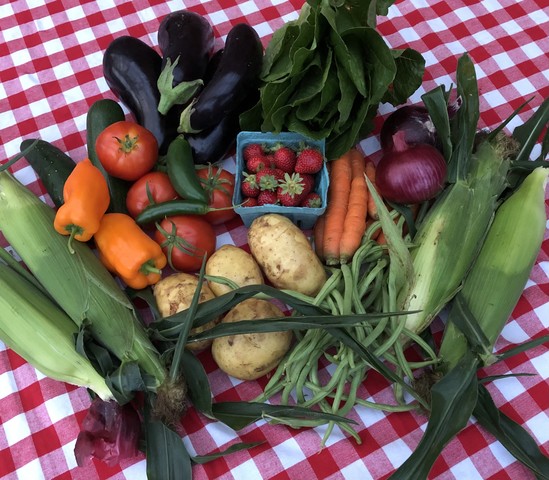- Carrots
- Sweet Corn
- Cucumbers
- Eggplant
- Head Lettuce
- Sweet Peppers
- Hot Peppers
- New Potatoes
- Strawberries
- Zucchini
- Tomatoes
On Rotation:
- Green Beans
- Walla Walla Sweet Onions
- Red Onions
Spud Magic
If you've been a CSA member in year's past, you might be wondering why you're getting new potatoes in your share rather than the usual cured potatoes we typically give out. New potatoes are smaller, have fragile skins, need to be refrigerated and don't hold up in long-term storage like cured potatoes. AND they are delicate and tender and delectable! Most people associate them with early summer, when you "rob" your potatoes of their first tubers just when the plants begin to flower.
This year on the farm, in addition to our usual storage potato crop, we're growing successions of new potatoes intentionally and strategically as an offensive tactic against symphylans. Symphylans are a dreaded soil-dwelling pest that feeds on root hairs and can do extensive damage to certain crops. They are a major mystery to researchers and farmers alike and hard to control. The one thing that has shown promising results in organic systems is potatoes: if you grow potatoes in symphylans-infested soil, you can usually get one to three good years of symphylans-free crop production from that ground. No one knows why. We used that information last year when we discovered we had a major symphylans problem in the early spring. We lost all of our early brassicas in one zone, forcing us to do a quick juggle of our crop rotation. We replanted the spring brassicas elsewhere and put potatoes where the symphs were rearing their head. We had a great potato year from that ground (the symphs don't damage or reduce yields in spuds). This summer we planted our fall and overwintering brassicas there - crops that are very susceptible to symphs - and they are thriving! It was nerve-wracking to commit our entire fall and winter brassical field to a spot where brassicas bit the dust a year earlier, and amazing to see how healthy and vibrant the plants are right now. Quasi-miraculous. I wish we understood WHY the potatoes supress the symphylans, but thus far no one knows.
A researcher and friend at OSU, Nick Andrews, has been doing trials with new potatoes and has found that even 4-6 weeks of new potatoes in the ground can achieve this result. Which is great news because it means we can use quick crops of new potatoes to spot-treat other zones in the field. The benefit of this approach is that we don't have to commit the ground to a full season of potato production, and it means we're all eating yummy new potatoes in September! Meanwhile, we've been pulling major tonnage of our storage potatoes out of the field with the help of the horses, so no matter what there are lots of spuds in your future this fall and winter. Hopefully the sum total of all this potato effort is a significant reduction in the symphylans population and more healthy, productive plants in every corner of the farm.

